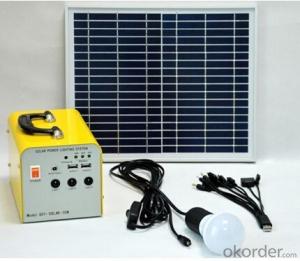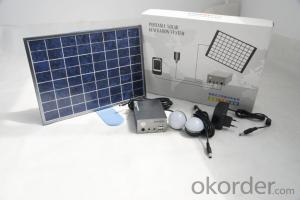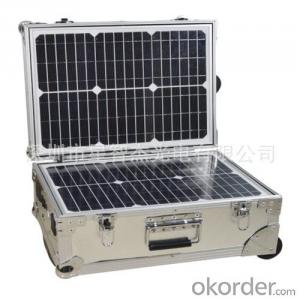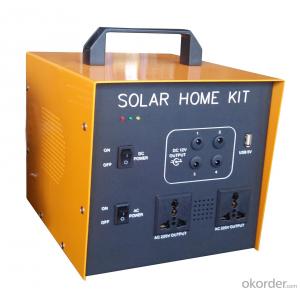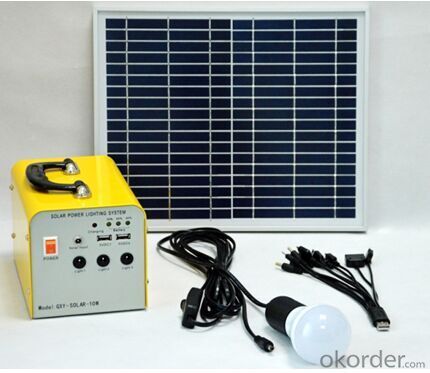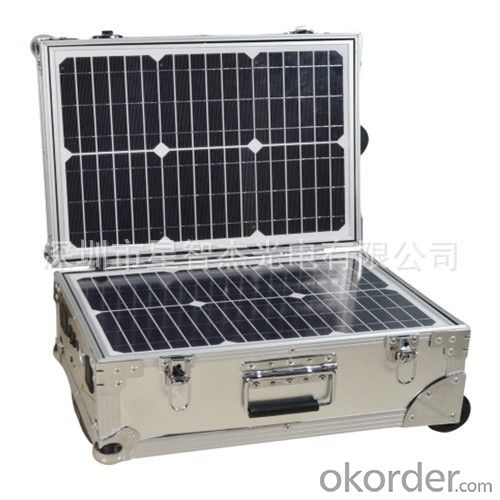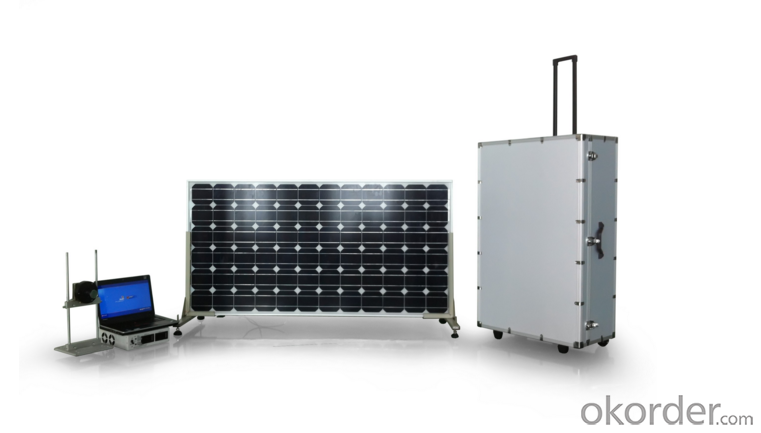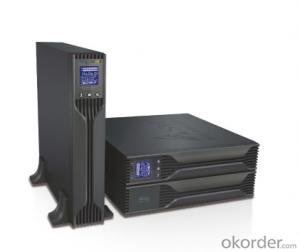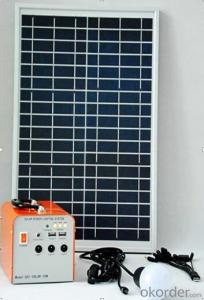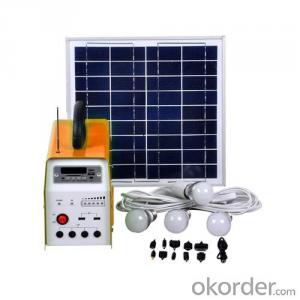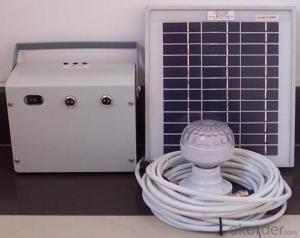Long Island Solar Energy Systems - Solar Portable System AN-S3W
- Loading Port:
- Shanghai
- Payment Terms:
- TT OR LC
- Min Order Qty:
- 0 set
- Supply Capability:
- 10000 set/month
OKorder Service Pledge
OKorder Financial Service
You Might Also Like
Specification
Description of Solar Portable System AN-S3W
Compatible portable solar power supply, also called solar mobile power, it includes: solar panel, charge controller, discharge controller, electric charge controller, inverter, outside enlarge capacity interface and battery, etc. Photovoltaic portable power supply can work in solar energy and ordinary power two modes, and can automatically switch. Photovoltaic portable power supply is used widely is the emergency relief, tourism, army, geological prospecting, archaeology, schools, hospitals, Banks, gas stations, comprehensive building, highway, substation, family camping or outdoor activities such as emergency power ideal power supply equipment.
Specifications of Solar Portable System AN-S3W
1. Solar Panel: 3W 9V
2. Battery: 6V4.5A lead-acid battery
Input terminal: 1 DC input, 9V
Output terminal: 4 output terminals, including:
1x USB output, 5V 1A;
3x DC outputs, 6V 1A
Switch: one square On/Off general switch
Indication lamp: 2 pcs; Red one is for charging indication, Green one is for operating indication.
Accessories of Solar Portable System AN-S3W
1. 2pcs 2.2W led bulbs;
2. 1pc 3m connection wire between solar panel and cabinet;
3. 2pcs lamp holder with 3m wire;
4. 1pc AC charger
Technical Data of Solar Portable System AN-S3W
| Internal Package Size (cm) | 20*18*21 |
| Packing QTY | 12 |
| External Package Size (cm) | 62*42*42 |
IMages of Solar Portable System AN-S3W
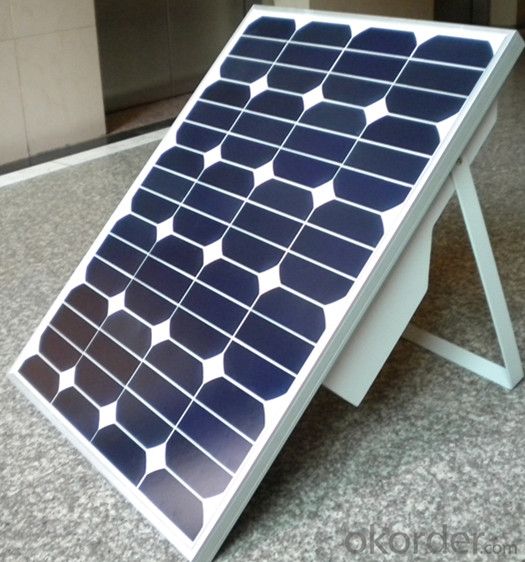

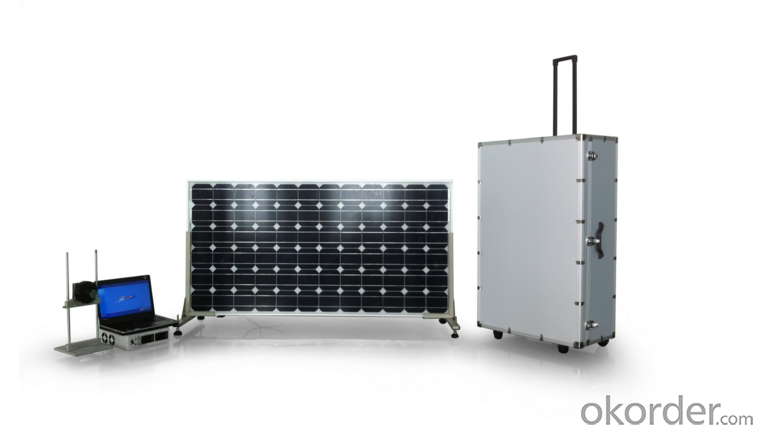
FAQ:
1. How long will my inquiry get response?
Your inquiry related to our products or prices will be replied within 24 hours.
2. Can I get professional service and suggestion?
Well-trained and experienced staffs to answer all your questions in fluent English.
3. Do you accept OEM or customized design?
OEM & ODM, any your customized lightings we can help you to design and put into product.
4. What if I need specific design?
Distributorship are offered for your unique design and some our current models.
- Q: What are the devices needed for PV systems?
- Battery pack. The utility model is used for storing the electric energy generated by the solar array when illuminated by the light and can supply power to the load at any time. In the grid connected solar power generation system, the battery can not be added
- Q: Can solar energy systems be used in powering recycling plants or waste management facilities?
- Yes, solar energy systems can definitely be used to power recycling plants or waste management facilities. Solar energy systems harness the power of the sun to generate electricity, which can be used to operate various equipment and machinery in these facilities. Recycling plants and waste management facilities typically require a significant amount of energy to power their operations, including sorting and processing machines, conveyor belts, and other equipment. By installing solar panels on the roofs or in the vicinity of these facilities, they can generate clean and renewable electricity to significantly reduce their reliance on traditional energy sources. Solar energy systems offer several advantages for recycling plants and waste management facilities. Firstly, they provide a reliable and consistent source of energy, as the sun is abundant and available in most regions throughout the year. Unlike fossil fuels or other non-renewable energy sources, solar energy systems do not deplete natural resources or contribute to greenhouse gas emissions, making them environmentally friendly. This aligns with the sustainability goals of recycling plants and waste management facilities, which are focused on reducing the environmental impact of waste management processes. Additionally, solar energy systems can help these facilities save on energy costs. Once the initial investment in solar panels is made, the ongoing operational costs are relatively low. Furthermore, some regions offer incentives and financial support for the installation of solar energy systems, which can further offset the initial investment and make it more financially attractive. Furthermore, recycling plants and waste management facilities often have large surface areas available for solar panel installations, such as rooftops or open fields. This makes it easier to install a sufficient number of solar panels to meet the energy demands of these facilities. In some cases, excess energy generated by the solar panels can even be fed back into the electrical grid, allowing the facilities to earn revenue from the surplus electricity. In conclusion, solar energy systems can be effectively used in powering recycling plants or waste management facilities. They offer a sustainable and cost-effective solution, reducing reliance on traditional energy sources while helping these facilities achieve their environmental goals.
- Q: Are there any financing options available for purchasing solar energy systems?
- Yes, there are several financing options available for purchasing solar energy systems. These include solar loans, leases, power purchase agreements (PPAs), and government incentives such as tax credits and grants. These options aim to make solar energy more affordable and accessible for individuals and businesses.
- Q: Can solar energy systems be installed in areas with high winds?
- Yes, solar energy systems can be installed in areas with high winds. In fact, it is important to consider wind speeds when installing solar panels to ensure their structural integrity and longevity. Solar panels are designed to withstand various weather conditions, including high winds. Proper installation techniques, such as utilizing strong mounting systems and securing panels with appropriate fasteners, can enhance their resistance to wind damage. Additionally, some solar panel manufacturers conduct rigorous testing to ensure their products can withstand high wind speeds. It is recommended to consult with a professional installer who can assess the specific conditions of the area and design a solar energy system that can effectively withstand high winds.
- Q: Can solar energy systems reduce electricity bills?
- Yes, solar energy systems can reduce electricity bills. By harnessing energy from the sun, these systems generate electricity that can power homes and businesses, significantly reducing reliance on traditional electricity sources. This can lead to substantial savings on monthly electricity bills, especially when combined with net metering or feed-in tariffs. Additionally, solar energy systems require minimal maintenance and have a lifespan of 25-30 years, making them a cost-effective long-term investment.
- Q: Can solar energy systems be used for powering signs or billboards?
- Yes, solar energy systems can definitely be used for powering signs or billboards. In fact, solar power is an excellent choice for such applications due to its numerous advantages. Solar energy systems consist of solar panels that convert sunlight into electricity, which can be used to power various devices and appliances, including signs and billboards. One of the key benefits of using solar energy for powering signs or billboards is that it is a clean and renewable source of energy. Solar power does not produce any harmful emissions or pollutants, making it an environmentally friendly option. This is particularly important for outdoor signs and billboards that are often located in public areas. Moreover, solar energy systems are highly reliable and require minimal maintenance. Once installed, the solar panels can generate electricity for many years with very little upkeep. This makes solar power an ideal choice for signs or billboards that need to operate continuously or for extended periods without interruption. Furthermore, solar energy systems can be installed in various sizes and configurations, allowing for flexibility in design and placement of signs or billboards. Solar panels can be mounted on rooftops, poles, or even integrated into the design of the sign itself. This versatility makes solar power a suitable option for both new installations and retrofitting existing signs or billboards with solar panels. From an economic standpoint, solar energy can also provide long-term cost savings. While the initial installation costs may be higher compared to traditional electrical connections, solar power eliminates the need for ongoing electricity bills. Once the system is in place, the energy generated by the solar panels is essentially free, resulting in significant savings over time. In conclusion, solar energy systems can certainly be used to power signs or billboards. The clean and renewable nature of solar power, combined with its reliability, low maintenance requirements, and design flexibility, make it a highly suitable and sustainable choice for such applications.
- Q: Are there any risks of theft or vandalism with solar energy systems?
- Yes, there are some risks of theft or vandalism associated with solar energy systems. Solar panels, inverters, and batteries can be attractive targets for thieves due to their high value. Additionally, vandalism can occur, such as intentional damage to solar panels or theft of crucial components. However, there are preventive measures that can be implemented, such as installing security systems, using tamper-proof equipment, and ensuring proper insurance coverage to mitigate these risks.
- Q: Can solar energy systems be installed on sports facilities or stadiums?
- Yes, solar energy systems can be installed on sports facilities or stadiums. In fact, many sports facilities and stadiums around the world have already incorporated solar energy systems to reduce their carbon footprint and lower energy costs. These systems can generate electricity by harnessing the power of the sun, providing a sustainable and renewable source of energy for the facility. Additionally, the large roof spaces and open areas of sports facilities make them ideal for solar panel installations.
- Q: What is the lifespan of solar batteries?
- The lifespan of solar batteries can vary depending on several factors. Generally, high-quality solar batteries can last anywhere from 5 to 15 years. However, with proper maintenance and care, some batteries have been known to last up to 20 years or more. The lifespan of solar batteries is influenced by factors such as the type and quality of the battery, the depth of discharge (how much energy is used before recharging), the frequency of charging and discharging cycles, and the overall maintenance of the battery system. It's important to note that over time, the capacity of solar batteries may decrease, resulting in reduced energy storage capabilities. This gradual decline in capacity is known as battery degradation. While it is an inevitable process, proper care and maintenance can help slow down the rate of degradation. Regularly monitoring the battery's state of charge, avoiding deep discharges, and ensuring proper ventilation and temperature control can all contribute to prolonging the lifespan of solar batteries. Additionally, following the manufacturer's guidelines for maintenance and replacement can help maximize their longevity. Overall, investing in high-quality solar batteries, coupled with proactive maintenance, can significantly extend their lifespan, providing reliable and sustainable energy storage for your solar power system.
- Q: How do solar energy systems contribute to reducing electricity bills?
- Solar energy systems contribute to reducing electricity bills by harnessing the power of the sun to generate electricity. By generating their own electricity, homeowners and businesses can significantly reduce their reliance on the grid and therefore lower their monthly electricity bills. Additionally, excess energy produced by solar panels can be fed back into the grid, allowing for net metering and further reducing electricity costs.
Send your message to us
Long Island Solar Energy Systems - Solar Portable System AN-S3W
- Loading Port:
- Shanghai
- Payment Terms:
- TT OR LC
- Min Order Qty:
- 0 set
- Supply Capability:
- 10000 set/month
OKorder Service Pledge
OKorder Financial Service
Similar products
Hot products
Hot Searches
Related keywords
